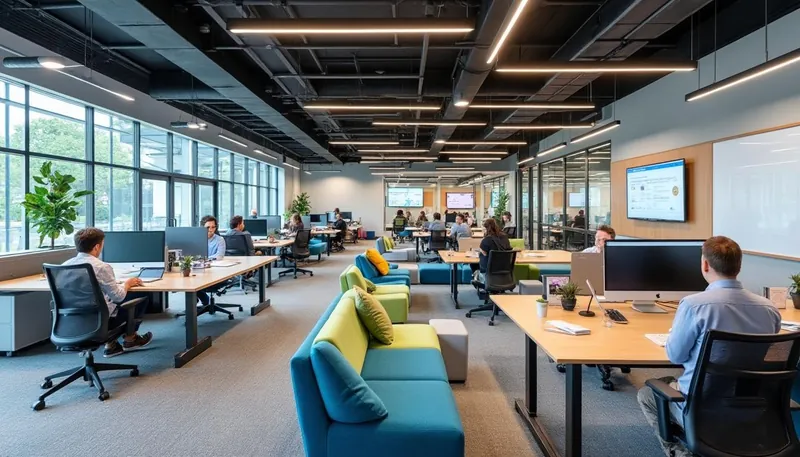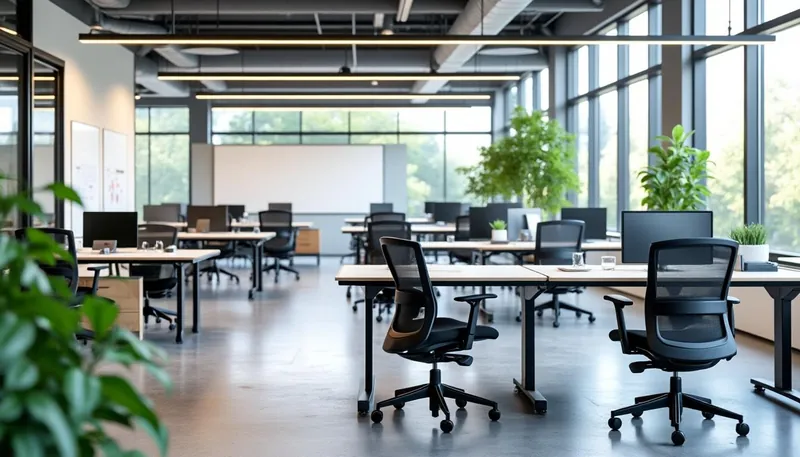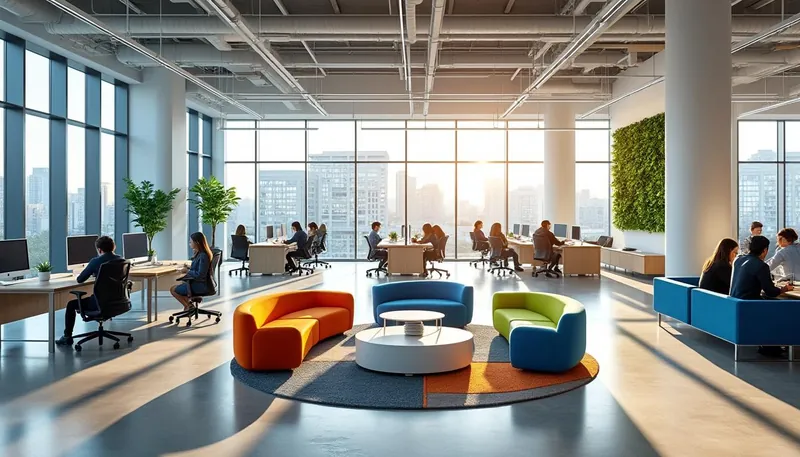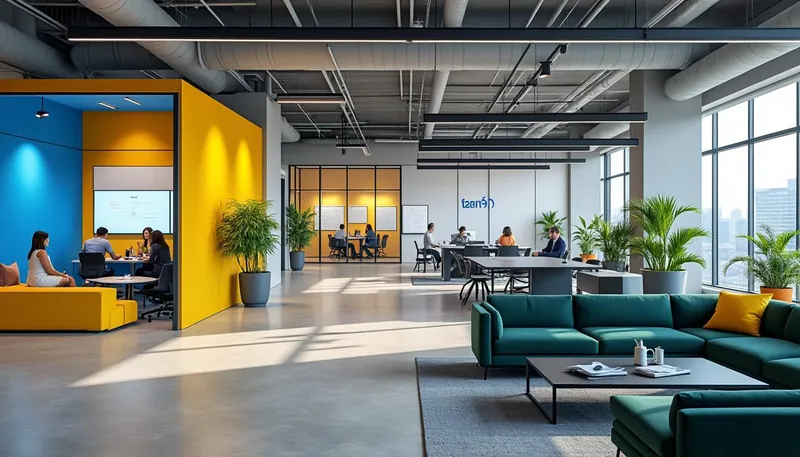As workplaces continue to evolve in response to technological advancements and changing employee needs, the concept of desk-to-employee ratios has gained significant attention. The traditional model of a one-to-one desk ratio is becoming less applicable as companies increasingly adopt more flexible work arrangements. In 2025, businesses are finding themselves navigating hybrid work models that blend remote work and in-office tasks, leading to new strategies for optimizing space utilization. With this transformation, the desk-sharing ratio — the balance of desks available compared to employees using them — becomes a critical factor. The transition not only maximizes efficiency but also accommodates varying employee needs. In this context, understanding and defining the ideal desk-to-employee ratio is key to creating a productive and supportive work environment.
Brief
- Understanding desk-to-employee ratios is essential for modern workplaces.
- The shift towards hybrid work models necessitates flexible space allocation.
- Optimal ratios can enhance productivity and employee satisfaction.
- Employing technology can streamline desk allocation processes.
- Continuous monitoring and adaptations ensure effectiveness of desk sharing strategies.
Defining Desk-to-Employee Ratios in Modern Workplaces
Before diving into the implications of desk-to-employee ratios, it’s crucial to define what this term actually means. Essentially, the desk-to-employee ratio, often referred to as the desk-sharing ratio, is the number of desks available compared to the total number of employees within a workplace. Traditionally, companies have operated under a 1:1 ratio, meaning each employee is allocated a personal desk. However, this model is quickly facing obsolescence, especially in light of more flexible working strategies.
In contemporary structures, desk-sharing arrangements, such as hot desking, are being implemented. These models allow multiple employees to use the same desk at different times, and they capitalize on the fact that not all employees are present in the office every day. For example, in a hybrid working environment, it’s common to achieve a desk-sharing ratio of anywhere between 0.5:1 to 0.8:1 — meaning that for every ten employees, there are between five to eight desks available.
Understanding the Shift in Modern Work Culture
This evolution aligns with the changing dynamics of workforce engagement and productivity. There are a few factors influencing this shift:
- Flexible Work Schedules: Many employees now split their workweek between remote and in-office days, leading to fluctuating desk requirements.
- Focus on Collaboration: Modern workspaces are increasingly designed to foster teamwork and collaboration, often requiring less physical desk space as a result.
- Technological Advances: Tools enabling efficient desk booking systems and real-time occupancy tracking have facilitated the move toward shared desks.
The desk-sharing ratio concept facilitates a more adaptive environment while allowing businesses to enhance their spatial efficiency. Employers must determine the necessary number of desks based on attendance patterns, ensuring an optimal mix of workspaces that cater to individual preferences and collaborative needs.
| Desk-Sharing Ratio | Description |
|---|---|
| 1:1 | One desk per employee; traditional office setup. |
| 0.8:1 | Eight desks for ten employees; popular in hybrid models. |
| 0.5:1 | Five desks for ten employees; emphasizes collaborative work. |

The Benefits of Optimizing Desk-to-Employee Ratios
Adopting a flexible desk-sharing model comes with an array of advantages that can significantly influence organizational success and employee satisfaction. Let’s explore the key benefits that arise from optimizing desk-to-employee ratios.
Cost Savings on Office Space
When businesses shift towards desk sharing, they unlock substantial cost savings associated with maintaining larger office spaces. With fewer desks needed, organizations can reduce their physical footprint. This often leads to savings on rent, utilities, and maintenance costs, offering a direct impact on the bottom line. For instance, organizations can see cost reductions between 15% to 30% based on their adjusted workspace size.
Enhanced Flexibility and Employee Autonomy
Another notable benefit of desk sharing is the increase in flexibility for employees. They can choose when and where they want to work, which is especially appealing to younger generations seeking a work-life balance that aligns with their personal lifestyles. Companies that emphasize flexibility often witness higher levels of employee engagement, loyalty, and retention.
Support for Sustainability Initiatives
Desk sharing also contributes to an organization’s sustainability efforts. By utilizing space more efficiently, companies can minimize the overall energy consumption associated with lighting, heating, and air conditioning. A smaller physical footprint can reduce environmental impact and align with the values of modern employees who prioritize sustainability in their career choices.
Furthermore, implementing workspace strategies that utilize less space while maximizing functionality and comfort creates a win-win scenario for both the employer and the employees. With the right design and technology, workplaces can enhance functionality while conserving resources.
| Benefit | Impact |
|---|---|
| Cost Savings | 15%-30% reduction in overhead costs. |
| Employee Flexibility | Higher engagement and job satisfaction. |
| Sustainability | Reduced energy consumption and smaller carbon footprint. |

Implementing Desk Sharing Successfully
Transitioning to a desk-sharing environment requires thoughtful planning and organization. To maximize the benefits of this model, businesses must consider various strategies for implementation.
Analyzing Workforce Patterns
The first step in implementing desk sharing is to have a clear understanding of the workforce and their patterns. Regular surveys can assess employees’ preferences and work habits, while occupancy sensors can provide crucial data on how workspace is utilized.
Choosing Technology Solutions
Ensuring that the transition to desk sharing is smooth involves leveraging technology that supports coordination of workspace usage. For instance, utilizing desk booking systems, like those offered by companies such as Herman Miller and Steelcase, can make it easier for employees to reserve desks and collaborate effectively. This technology can also yield analytics to inform future workspace decisions.
Establishing a Pilot Program
Before fully committing to a desk-sharing model, running a pilot program can be invaluable. It allows organizations to test the waters, gather insights from employees, and make necessary adjustments. During this phase, keeping communication lines open enables organizations to respond to any concerns or challenges employees might face.
- Conduct Surveys: Gage employee preferences on desk usage.
- Monitor Usage: Utilize technology to track desk occupancy.
- Analysis: Refine policies and systems based on feedback and data collected.
Ensuring Continuous Improvement in Desk Sharing
In the rapidly evolving workplace landscape, it’s essential to continuously analyze and improve desk-sharing strategies. Regularly monitoring desk utilization and conducting employee feedback surveys will help organizations keep up with changing needs while ensuring employee satisfaction.
Having mechanisms in place for regular reporting and analysis can streamline this process. Over time, companies can refine their understanding of best practices to optimize their desk-to-employee ratios further.
| Activity | Frequency |
|---|---|
| Employee Feedback Surveys | Quarterly |
| Desk Usage Monitoring | Monthly |
| Policy Review and Adjustments | Annually |
What is an ideal desk-to-employee ratio?
The ideal desk-to-employee ratio commonly ranges from 0.5:1 to 0.8:1 in hybrid workplaces, allowing for shared desk usage.
How can desk sharing benefit our business?
Desk sharing can lead to cost savings, improved employee satisfaction, and a reduced environmental footprint through efficient space utilization.
What technology can help with desk sharing?
Desk booking software and occupancy sensors are crucial in managing desk allocation effectively across diverse work environments.
How often should we review our desk-sharing policies?
Regular quarterly and annual reviews help organizations adapt to workforce changes and enhance workspace efficiency.
Can desk sharing improve employee collaboration?
Absolutely! By fostering a more dynamic workspace, desk sharing encourages collaboration among employees who may not work together regularly.


